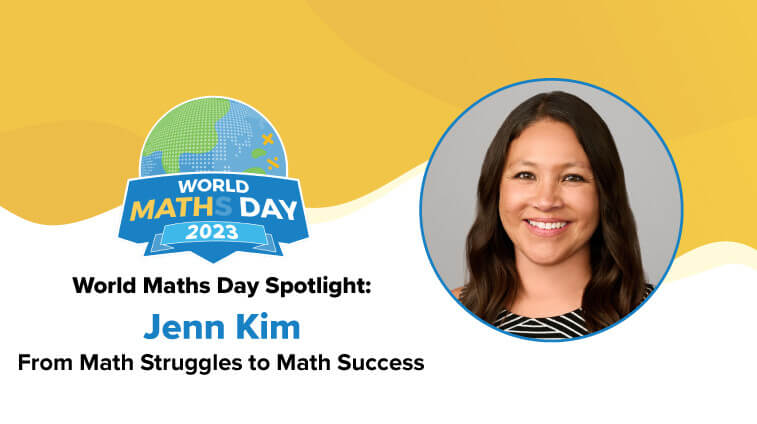Based on her line of work, one might assume that Jenn Kim had a natural talent or fondness for mathematics when she was younger.
As a veteran educator with over 20 years of experience, Jenn taught mathematics from second through ninth grade and at a college level. She was also an elementary and secondary math coach and a mentor for new teachers.
But mathematics didn’t always come easy for her. In fact, she really struggled with it.
“As a child, I did not fit that mold and I found that math was very challenging for me,” said the Mathematics Education Specialist based in California.
So how did she come to embrace the subject? It was all thanks to her eighth-grade teacher, Mrs Miller.
“She’s the one that really turned it on for me. From there it just became my passion and mission to really help students understand that they are all mathematicians, we can all do math,” Jenn added.
What causes math anxiety?
According to Trena Wilkerson, President of the National Council of Teachers of Mathematics, most children feel enthusiastic about learning mathematics when they start school. However, various factors, such as the need to perform calculations, can quickly trigger anxiety.
Jenn recalls, “I can vividly remember sitting in my second-grade class learning about the times tables. My teacher went down each row asking for the answer to a multiplication fact. My heart raced as I waited for my turn; multiplication just didn’t make sense to me.”
“I was in tears by the time she got to me and felt the eyes of every classmate on me. ‘I don’t know’ became my usual response in math class that year and for many years that followed. A ‘math wall’ had gone up.”
She even pleaded with her parents to buy her a multiplication chart to keep in her desk so she could glance at it whenever her teacher asked her multiplication facts.
Another contributing factor to math anxiety is that there can only be one right answer, or that there’s an assumption there’s only one way to solve a problem. However, Jenn shares that “this puts a lot of pressure on students, who all think and learn in different ways.”
Jenn, who now writes the worked solutions for the courses in Mathletics elaborates, “The beauty of math is there are multiple pathways to reach the same answer.”
“Students come to school with a lot of knowledge in their toolbox and should feel confident showing their thinking in a way that makes sense to them, with teacher guidance that addresses any misconceptions.”
What teachers and parents can do to reduce math anxiety
The good news is teachers and parents can help children develop a more positive math identity.
Showing how mathematics is used in everyday life gives context for the learning. From planning a garden to baking and shopping for groceries, there are many activities that require some form of mathematics such as measuring, counting and adding.
Teaching in small groups and using math programs helps lessen anxiety too.
Small-group learning improves academic achievement, relationships with peers and promotes well-being, while the open-ended nature of activities in math programs like Mathletics helps because there are multiple solution paths to get to the same answer.
For example, there is no one fixed solution in Mathletics’ Problem Solving and Reasoning activities.
Jenn shares this allows students to think, ‘I can do this because I have a set of tools that I can apply to these problems.’
Group games and competitions have also proved highly effective in helping children to relax and have fun with numbers. One such free event World Maths Day, a 48-hour online ‘live’ competition happening on 8th March 2023.
“World Maths Day allows students to work on their mathematics facts in a competitive and engaging way. They can choose to play against the computer, challenge their peers in their class or at their school, or compete with other children from around the world,” Jenn explained.
She reveals that “teachers can also privately set the difficulty level for each student on their end, so students can participate with just the right amount of challenge and not feel compared against their peers.”
Every child is a math child
Jenn stresses that it is crucial for teachers to help students develop a positive math identity and let them know that “everybody can do math” because “every child is a math child”.
One way to do this is to have students share different solution paths and label them by name – for example ‘Michela’s method’ or ‘Tariq’s way’.
“Continue to call the strategies by your students’ names and post them around the classroom for reference,” the veteran educator said. She also suggests a ‘Math Teacher for the Day’ so students can be the expert at a concept or strategy they want to share.
The idea is “to create opportunities for students to be confident in their learning and to celebrate different ways of thinking.”
“I had an amazing teacher who visually broke down the math concepts. She always had multiple ways of approaching a problem. From then, I started understanding concepts better instead of solely relying on memory and following steps.”
She exclaims, “All of a sudden, the light went on and I started loving math! I went on to being only one out of three students to pass the AP Calculus AB test in my senior year of high school.”
As an elementary and middle school teacher, Jenn started to understand the math concepts even better. She had even more ‘a-ha’ moments as she studied how to teach math, not just ‘do math.’
“Thanks to Mrs. Miller, my ‘math wall’ was broken.”
It’s clear that Jenn’s passion for mathematics and ensuring that every child feels like they can do math is on top of her mind. She hopes that her story can inspire students to overcome their ‘math wall’ and aspires to help students around the world become more confident mathematicians.
“It really is important to me, to bring my journey out into the world so that students really feel like ‘wow yeah, I can do math too.’”









